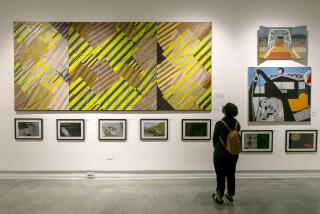Alleged Rembrandts May Have Painted Couple Into a Corner
- Share via
The offer was described as a once-in-a-lifetime opportunity, Joan Orlando said in her lawsuit, and she couldn’t resist.
Prints conceived and produced by Rembrandt. Rare examples of the work of the celebrated 17th-Century Dutch master. A unique opportunity to purchase works from an anonymous European museum desperate for cash. That is how Orlando remembers what she was told.
And so Orlando, an assistant professor of anthropology at USC, and her husband, Whittier pathologist Robert Orlando, bought three prints for $18,975 from the Signature Fine Arts Gallery on Nov. 5, 1982.
A week later, the Orlandos allege, they learned that the prints had not been made personally by Rembrandt and were worth perhaps $100 each. What followed was a fraud lawsuit that is scheduled to go to trial today in Orange County Superior Court.
“We felt we were buying a piece of history, an authentic work done by the hand of Rembrandt,” Joan Orlando said. “It really, really hurts and infuriates us to have been duped this way.”
The defendants deny the Orlandos’ allegations and have filed claims against each other concerning the manner in which the prints were marketed.
Steven Silverstein, attorney for Shawn Miranda, the sales person who dealt with the Orlandos, said: “This is a simple case that sounds like a very confusing one.”
Miranda is one of seven defendants. The others are the Signature gallery; Signature officials Ronald Copple and Thomas Reed Rogers; Goldmanart Inc. of Los Angeles, which owned two of the three prints the Orlandos bought and had consigned them to Signature for sale; Robert K. Goldman, head of Goldmanart, and Goldmanart employee Mary Ann Woods.
“I don’t believe there’s any fraud,” Silverstein said. “The very most a jury could find is that there was a misunderstanding. There would be an order to return the prints and refund the price.”
In their lawsuit, however, the Orlandos have asked for damages up to $150,000. Their attorney, William Bernstein, believes that the key fraud allegations should boost the expected recovery. Those allegations accuse all the defendants of intentionally misleading the Orlandos into believing that Rembrandt had personally made the prints they bought.
Plaintiffs and defendants alike agree that the three etchings the Orlandos bought were conceived by Rembrandt, who produced 300 metal plates etched with pictures during his career.
The issue is who actually made the prints.
Such prints are made with a copper plate with furrows and grooves onto which the artist rubs ink to print an image on paper or cloth.
The problem, the Orlandos discovered, was that Rembrandt continually reworked his plates while he lived, and others did the same after he died. By far, the most valuable are those done by the artist himself. They are called “lifetime” renderings. Those pulled from the artist’s plates after his death are variously decribed as seconds, replicas and copies.
Robert Orlando said that before the purchase he didn’t even realize that Rembrandt made etchings. He viewed the deal as an investment, a start on a retirement nest egg. Now, he said, the prints are kept hidden away.
“You don’t want to have your failures hanging on the wall,” he said.
“They had never collected anything like this before,” Bernstein said. “Her field is American Indian culture. They knew of Rembrandt but mainly as a painter.”
Bernstein said “curiosity” and advertising about the Rembrandt exhibit drew them to the gallery.
One radio spot talked of the “treat” of Rembrandt for Newport Beach art lovers, Bernstein said. The show was said to be possible only because a “museum in Europe” had to sell, making the display “the largest collection of Rembrandt etchings to come to the United States in years,” he added.
Bernstein said a package of material given to gallery sales people described the collection as “17th Century.” An ad in a local newspaper made the same claim, according to Bernstein. Rembrandt died in 1669, and the oldest of the prints was actually produced in the late 1700s, according to the lawsuit.
“They were clearly saying these were originals,” Bernstein contends.
After the purchase, “I was naturally curious,” Joan Orlando said. “My field is research. I was interested in finding out as much as I could about what we had bought.”
The Orlandos took the prints to Ebria Feinblatt, formerly curator of the prints department of the Los Angeles County Museum of Art.
“It was at that time that we learned that we had not bought etchings done by the hand of Rembrandt but impressions taken from the reworked plates, done 120 years after he died,” Joan Orlando said.
The Orlandos then went back to see Miranda. She referred them to Copple and Rogers.
Copple and Rogers called in Goldman and Woods.
At this point, there is contention among the defendants. Rogers has filed claims against Copple--who, along with Signature, has filed a $1-million claim against the Orlandos for defamation. Goldmanart claims that it did everything right in providing complete information on the prints when they were consigned to Signature.
In pretrial papers, in fact, lawyers for Goldmanart claim that Goldman, concerned about promotional activities, “even told Signature that Signature’s print advertising was misleading as printed . . . .”
Bernstein said he expects the trial, scheduled before Superior Court Judge Robert C. Todd, to last four weeks.
More to Read
The biggest entertainment stories
Get our big stories about Hollywood, film, television, music, arts, culture and more right in your inbox as soon as they publish.
You may occasionally receive promotional content from the Los Angeles Times.










